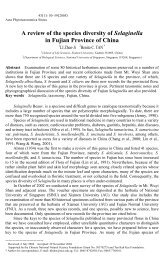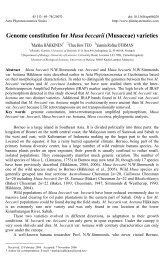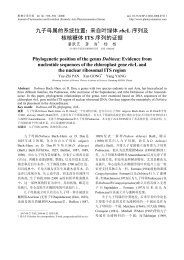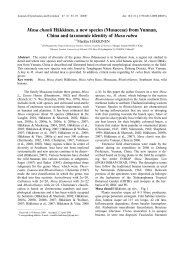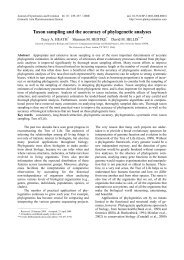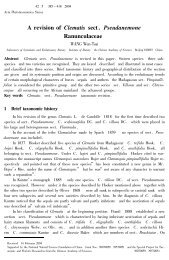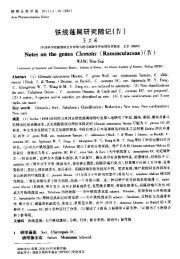Paeonia cathayana D. Y. Hong & K. Y. Pan, a new tree peony, with ...
Paeonia cathayana D. Y. Hong & K. Y. Pan, a new tree peony, with ...
Paeonia cathayana D. Y. Hong & K. Y. Pan, a new tree peony, with ...
Create successful ePaper yourself
Turn your PDF publications into a flip-book with our unique Google optimized e-Paper software.
45 (3): 285–288(2007)<br />
Acta Phytotaxonomica Sinica<br />
doi:10.1360/aps07043<br />
http://www.plantsystematics.com<br />
<strong>Paeonia</strong> <strong>cathayana</strong> D. Y. <strong>Hong</strong> & K. Y. <strong>Pan</strong>, a <strong>new</strong> <strong>tree</strong> <strong>peony</strong>,<br />
<strong>with</strong> revision of P. suffruticosa ssp. yinpingmudan<br />
HONG De-Yuan * PAN Kai-Yu<br />
(State Key Laboratory of Systematic and Evolutionary Botany, Institute of Botany, the Chinese Academy of Sciences,<br />
Beijing 100093, China)<br />
Abstract Molecular data and <strong>new</strong> additional morphological data suggest that the two <strong>tree</strong><br />
peonies, based on which <strong>Paeonia</strong> suffruticosa ssp. yinpingmudan was described as <strong>new</strong>,<br />
belong to two entities, the one from Anhui (K. Y. <strong>Pan</strong> and Z. W. Xie 9701, the type) being a<br />
member of P. ostii, while the other from Song Xian, Henan Province (D. Y. <strong>Hong</strong> et al.<br />
H97010) being a <strong>new</strong> taxon. P. suffruticosa ssp. yinpingmudan is here reduced as a synonym<br />
of P. ostii, and P. <strong>cathayana</strong> D. Y. <strong>Hong</strong> & K. Y. <strong>Pan</strong> is described as <strong>new</strong> based on the<br />
specimen from Henan. The <strong>new</strong> species is closely related to P. ostii and P. jishanensis, but it<br />
differs from the former in having lower leaves <strong>with</strong> 9 leaflets and petals rose, while from the<br />
latter in having leaflets glabrous, ovate or ovate-lanceolate, less lobed, sepals all caudate at the<br />
apex and petals rose.<br />
Key words <strong>Paeonia</strong>, taxonomic revision, <strong>new</strong> species, <strong>Paeonia</strong> <strong>cathayana</strong> D. Y. <strong>Hong</strong> & K.<br />
Y. <strong>Pan</strong>, <strong>Paeonia</strong> suffruticosa ssp. yinpingmudan, China.<br />
When we (<strong>Hong</strong> et al., 1998) described <strong>Paeonia</strong> suffruticosa ssp. yinpingmudan as <strong>new</strong>,<br />
we cited two specimens, one from a cliff in the Yinping Hill, Chaohu, Anhui Province (K. Y.<br />
<strong>Pan</strong> & Z. W. Xie 9701), and the other from a cultivated shrub by Mr. YANG Hui-Fang’s<br />
house in Secaogou Village, Shigunping, Muzhijie Township, Song Xian, Henan Province (D.<br />
Y. <strong>Hong</strong> et al. H97010). The former, which was bought from a local farmer, has only one leaf<br />
and several petals (white), while the latter, <strong>with</strong> rose petals, was introduced from a nearby<br />
mountain around 1961, as said by Mr. YANG. They were then considered forming a single<br />
entity and possibly a wild form of the cultivated <strong>tree</strong> <strong>peony</strong> on the basis of similarity of the<br />
leaves, though they have different petal colours. It is regretful that we designated 9701,<br />
instead of H97010, as the type of P. suffruticosa ssp. yinpingmudan, considering that the<br />
former came from an individual of wild origin <strong>with</strong> considerable certainty, but ignoring its<br />
incompleteness as a specimen, particularly as a type.<br />
Our recent DNA sequencing data do not support our taxonomic treatment. Nuclear<br />
GPAT gene sequencing shows that 9701 and two samples of P. ostii T. <strong>Hong</strong> & J. X. Zhang<br />
form a clade <strong>with</strong> bootstrap of 100% (Zhao et al., 2004), whereas H97010 forms a separate<br />
clade (Zhou et al., unpublished). The molecular data from a nuclear gene family, Adh 1A ,<br />
Adh 1B and Adh 2 also demonstrate that 9701 and P. ostii form a clade, <strong>with</strong> bootstrap<br />
respectively 54% (Adh 1A ), 100% (Adh 1B ) and 58% (Adh 2 ), while H97010 forms another clade<br />
<strong>with</strong> P. qiui Y. L. Pei & D. Y. <strong>Hong</strong> <strong>with</strong> bootstrap respectively 96% (Adh 1B ) and 66%<br />
(Adh 2 )(Lin et al., 2004). On a cpDNA <strong>tree</strong> 9701 forms a clade first <strong>with</strong> P. ostii but not <strong>with</strong><br />
H97010, which forms an independent clade (Zhou et al., unpublished).<br />
Facing the results of multigenic analysis mentioned above we began to doubt our<br />
taxonomic treatment (<strong>Hong</strong> et al., 1998). Haw (2006) strongly argued that <strong>Paeonia</strong><br />
<br />
Received: 9 March 2007 Accepted: 9 April 2007<br />
Supported by grant of the National Geographic Society, USA, Grant No. 5515-95.<br />
* Author for correspondence. E-mail: hongdy@ibcas.ac.cn.
286<br />
Acta Phytotaxonomica Sinica Vol. 45<br />
Fig. 1. A lower leaf of P. ostii T. <strong>Hong</strong> & J. X.<br />
Zhang. Drawn by Mr. SUN Ying-Bao from the<br />
individual on cliff of the Yinping Shan.<br />
suffruticosa ssp. yinpingmudan from Anhui is an<br />
element of P. ostii, but not the direct progenitor of<br />
P. suffruticosa Andrews. According to his<br />
observation, the <strong>peony</strong> on the cliff has lower leaves<br />
<strong>with</strong> 11 instead of 9 leaflets. For more information<br />
of the wild <strong>peony</strong> on the cliff in the Yinping Hill,<br />
Anhui (9701), Mr. LI Min and Mr. MA Xin-Tang<br />
made a trip to the hill in April of 2006. They<br />
collected petals falling down the cliff and took a<br />
large number of photos using a telelens. Lower<br />
leaves of the <strong>tree</strong> <strong>peony</strong> on the cliff actually have 13<br />
(but not 9) leaflets, which are ovate-lanceolate or<br />
ovate, and mostly entire (Fig. 1). The leaf of the<br />
type specimen of P. suffruticosa ssp. yinpingmudan<br />
(9701, <strong>with</strong> 9 leaflets) (<strong>Hong</strong> et al., 1998) might be<br />
a middle but not lower one. Its flowers are purely<br />
white, <strong>with</strong> purple filaments and disc. Therefore,<br />
there are no significant differences between the <strong>tree</strong><br />
<strong>peony</strong> (9701) and the specimens of P. ostii we have<br />
so far examined. However, the <strong>tree</strong> <strong>peony</strong> in Song<br />
Xian of Henan Province (H97010) (Fig. 2) differs<br />
from it in having lower leaves strictly <strong>with</strong> nine leaflets, mostly lobed, and having petals rose.<br />
Based on the knowledge we have now, the two <strong>tree</strong> peonies, cited when P. suffruticosa ssp.<br />
yinpingmudan was described as <strong>new</strong>, actually belong to two entities, 9701 being an element<br />
of P. ostii, whereas H97010 might be a real wild form of the cultivated <strong>tree</strong> <strong>peony</strong>. Thus,<br />
<strong>Paeonia</strong> suffruticosa ssp. yinpingmudan should be reduced as a synonym of P. ostii, while the<br />
<strong>tree</strong> <strong>peony</strong> from Henan may be described as a <strong>new</strong> species.<br />
<strong>Paeonia</strong> <strong>cathayana</strong> D. Y. <strong>Hong</strong> & K. Y. <strong>Pan</strong>, sp. nov. Fig. 2<br />
<br />
Type: China. Henan ( ), Song Xian ( ), Muzhijie Township ( ),<br />
Shigunping ( ), Secaogou Village ( ), cultivated by Mr. YANG Hui-Fang’s<br />
house, 1997-04-28, D. Y. <strong>Hong</strong> et al. ( ) H97010 (holotype, here designated, PE)<br />
(<strong>Hong</strong> et al., 1998. pl. 1: 3).<br />
<strong>Paeonia</strong> suffruticosa ssp. yinpingmudan D. Y. <strong>Hong</strong>, K. Y. <strong>Pan</strong> & Z. W. Xie in Acta<br />
Phytotax. Sin. 36: 519. 1998, p.p., quoad specim. ex Henan.<br />
<strong>Paeonia</strong> yinpingmudan (D. Y. <strong>Hong</strong>, K. Y. <strong>Pan</strong> & Z. W. Xie) B. A. Shen ssp. henanensis<br />
(D. Y. <strong>Hong</strong>, K. Y. <strong>Pan</strong> & Z. W. Xie) B. A. Shen in Lishizhen Medic. Mater. Med. Res. 12:<br />
330. 2001. nom. illeg.<br />
Mr. B. A. Shen’s P. yinpingmudan ssp. henanensis (Shen, 2001) is an illegitimate name,<br />
because D. Y. <strong>Hong</strong> and his coworkers have never given the Latin name “henanensis”, and<br />
Shen did not designate a type for his name “henanensis” either. However, from Shen’s short<br />
note in Chinese his “henanensis” is clearly connected <strong>with</strong> D. Y. <strong>Hong</strong> et al. H97010.<br />
A P. ostii T. <strong>Hong</strong> & J. X. Zhang foliolis 9, plerumque integris et petalis roseis differt; a<br />
P. jishanensis T. <strong>Hong</strong> & W. Z. Zhao foliis glabris, aliquod foliolis integris, sepalis omnino<br />
apice caudatis et petalis roseis differt.<br />
Shrubs about 0.8 m tall. Leaves glabrous; lower leaves <strong>with</strong> 9 leaflets; terminal leaflets<br />
8–10 cm long, 7–9 cm wide, 3- or 5-lobed to middle or even beyond, lateral leaflets ovate or<br />
ovate-lanceolate, 4–7 cm long, 2–4.5 cm wide, entire or shallowly lobed. Involucrate bracts
No. 3 HONG & PAN: <strong>Paeonia</strong> <strong>cathayana</strong>, a <strong>new</strong> <strong>tree</strong> <strong>peony</strong> 287<br />
A<br />
B<br />
Fig. 2. <strong>Paeonia</strong> <strong>cathayana</strong> D. Y. <strong>Hong</strong> & K. Y. <strong>Pan</strong>. A, a lower leaf; B, involucrate bracts and sepals. Drawn by Miss<br />
LI Ai-Li from D. Y. <strong>Hong</strong> et al. H97010.<br />
2–6. Sepals 4–5, glabrous, all caudate at the apex, 3–3.5 cm long, 2–3 cm wide. Flowers<br />
single, petals 9 or 10 in number, rose, broadly obovate, rounded at the apex, 5–6 cm long, 4–6<br />
cm wide. Filaments purple, anthers yellow. Disc purple. Stigma purple. Flowering from late<br />
April to early May.<br />
The <strong>new</strong> species is closely related to P. ostii and P. jishanensis T. <strong>Hong</strong> & W. Z. Zhao<br />
based on both morphology and molecular data. It differs from P. ostii in having lower leaves<br />
<strong>with</strong> 9 leaflets, petals rose, while from P. jishanensis in having leaves glabrous, lateral leaflets<br />
ovate or ovate-lanceolate, shallowly lobed or entire, sepals all caudate at the apex, and petals<br />
rose.<br />
Additional specimen examined:<br />
China. Hubei ( ): Baokang ( ), Houping Township ( ), Fanshenshang Village (<br />
), 2005-04-24, Z. L. Dai 2005001 (PE).<br />
<strong>Paeonia</strong> ostii T. <strong>Hong</strong> & J. X. Zhang in Bull. Bot. Res. (Harbin) 12: 223, fig. 1 (p. 231).<br />
1992.<br />
<strong>Paeonia</strong> suffruticosa ssp. yinpingmudan D. Y. <strong>Hong</strong>, K. Y. <strong>Pan</strong> & Z. W. Xie in Acta<br />
Phytotax. Sin. 36: 519, fig. 2. 1998, syn. nov. p.p., quoad specim. ex Anhui. <strong>Paeonia</strong><br />
yinpingmudan (D. Y. <strong>Hong</strong>, K. Y. <strong>Pan</strong> & Z. W. Xie) B. A. Shen in Lishizhen Medic. Mater.<br />
Med. Res. 12: 330. 2001. Type: China. Anhui ( ): Chaohu ( ), Mt. Yinping ( ),<br />
1997-04, K. Y. <strong>Pan</strong> & Z. W. Xie ( , ) 9701 (PE).<br />
<strong>Paeonia</strong> ostii T. <strong>Hong</strong> & J. X. Zhang var. lishizhenii B. A. Shen in Acta Phytotax. Sin.<br />
35: 360. 1997 <strong>Paeonia</strong> ostii ssp. lishizhenii (B. A. Shen) B. A. Shen in Lishizhen Medic.<br />
Mater. Med. Res. 12: 330. 2001. Type: China. Anhui ( ): Nanling ( ), Yashan, alt.<br />
200–250 m, 1984-04-18, B. A. Shen ( ) PB1018 (holotype in Wuhu Municipal Drug<br />
Bureau of Anhui Province; isotype, PE!).<br />
Acknowledgements Dr. ZHOU Shi-Liang provided us <strong>with</strong> his unpublished molecular data;<br />
Mr. LI Min and Mr. MA Xin-Tang made an important trip to Chaohu, Anhui Province; Mr.<br />
DAI Zhen-Lun sent his specimen to PE as a gift; Mr. SUN Ying-Bao and Miss LI Ai-Li drew
288<br />
Acta Phytotaxonomica Sinica Vol. 45<br />
the figures. To all of them we are greatly indebted.<br />
References<br />
Haw S G 2006. Tree peoniesa review of recent literature. The Plantsman (June 2006): 88–92.<br />
<strong>Hong</strong> D-Y ( ), <strong>Pan</strong> K-Y ( ), Xie Z-W ( ). 1998. Yinpingmudan, the wild relative of the<br />
king of flowers, <strong>Paeonia</strong> suffruticosa Andrews. Acta Phytotaxonomica Sinica ( ) 36:<br />
515–520.<br />
Lin Q B, Zhou Z Q, Zhao X, <strong>Pan</strong> K Y, <strong>Hong</strong> D Y. 2004. Interspecific relationships among the wild species of<br />
<strong>Paeonia</strong> sect. Moutan DC. based on DNA sequences of Adh gene family. Acta Hort. Sin., 31: 627–632.<br />
Shen B A ( ). 2001. Taxonomic identification and revision of medicinal plants in sect. Moutan of the<br />
genus <strong>Paeonia</strong>. Lishizhen Medicine Materia Medica Research (<br />
) 12: 330–333.<br />
Zhao X ( ), Zhou Z-Q ( ), Lin Q-B ( ), <strong>Pan</strong> K-Y ( ), <strong>Hong</strong> D-Y ( ). 2004.<br />
Molecular evidence for the interspecific relationships in <strong>Paeonia</strong> sect. Moutan: PCR-RFLP and sequence<br />
analysis of glycerol-3-phosphate acyltransferase (GPAT) gene. Acta Phytotaxonomica Sinica (<br />
) 42: 236–244.<br />
<br />
, *<br />
<br />
(<br />
, 100093)<br />
<br />
, <strong>Paeonia</strong> suffruticosa ssp. yinpingmudan<br />
<br />
, (<br />
9701, ) P.<br />
ostii , <br />
( H97010)<br />
P. suffruticosa ssp.<br />
yinpingmudan P. ostii , <br />
P. <strong>cathayana</strong> D. Y.<br />
<strong>Hong</strong> & K. Y. <strong>Pan</strong><br />
P. jishanensis , <br />
11–15 ,<br />
; <br />
, , <br />
, ; ; ; ; ;



